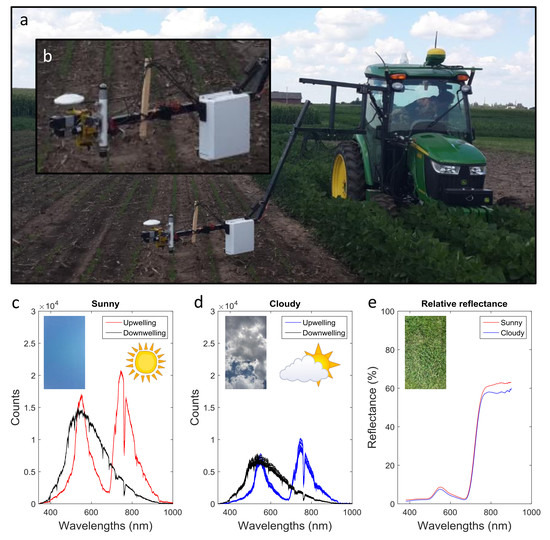Spectral Data Collection by Dual Field-of-View System under Changing Atmospheric Conditions—A Case Study of Estimating Early Season Soybean Populations
Abstract
:1. Introduction
2. Materials and Methods
2.1. Study Area and Trial Design
2.2. Spectral Data Collection
2.3. Data Processing and Statistical Analysis
3. Results and Discussion
4. Conclusions
Supplementary Materials
Author Contributions
Acknowledgments
Conflicts of Interest
References
- Lee, W.S.; Alchanatis, V.; Yang, C.; Hirafuji, M.; Moshou, D.; Li, C. Sensing technologies for precision specialty crop production. Comput. Electron. Agric. 2010, 74, 2–33. [Google Scholar] [CrossRef]
- Mulla, D.J. Twenty five years of remote sensing in precision agriculture: Key advances and remaining knowledge gaps. Biosyst. Eng. 2013, 114, 358–371. [Google Scholar] [CrossRef]
- Herrmann, I.; Pimstein, A.; Karnieli, A.; Cohen, Y.; Alchanatis, V.; Bonfil, D.J. LAI assessment of wheat and potato crops by VENμS and Sentinel-2 bands. Remote Sens. Environ. 2011, 115, 2141–2151. [Google Scholar] [CrossRef]
- Nigon, T.J.; Mulla, D.J.; Rosen, C.J.; Cohen, Y.; Alchanatis, V.; Knight, J.; Rud, R. Hyperspectral aerial imagery for detecting nitrogen stress in two potato cultivars. Comput. Electron. Agric. 2015, 112, 36–46. [Google Scholar] [CrossRef]
- Anderson, K.; Milton, E.J.; Rollin, E.M. Calibration of dual-beam spectroradiometric data. International J. Remote Sens. 2006, 27, 975–986. [Google Scholar] [CrossRef]
- MacLellan, C.J.; Malthus, T.J. High performance dual field of view spectrometer with novel input optics for, autonomous reflectance measurements over an extended spectral range. In Proceedings of the IEEE International Geoscience and Remote Sensing Symposium, Cape Town, South Africa, 12–17 July 2009; pp. 2163–2166. [Google Scholar]
- Meroni, M.; Barducci, A.; Cogliati, S.; Castagnoli, F.; Rossini, M.; Busetto, L.; Migliavacca, M.; Cremonese, E.; Galvagno, M.; Colombo, R.; et al. The hyperspectral irradiometer, a new instrument for long-term and unattended field spectroscopy measurements. Rev. Sci. Instrum. 2011, 82. [Google Scholar] [CrossRef] [PubMed]
- MacArthur, A.; Robinson, I.; Rossini, M.; Davis, N.; Mac Donald, K. A dual-field-of-view spectrometer system for reflectance and fluorescence measurements (Piccolo Doppio) and correction of etaloning. In Proceedings of the 5th International Workshop on Remote Sensing of Vegetation Fluorescence, Paris, France, 22–24 April 2014. [Google Scholar]
- Gaspar, A.P.; Conley, S.P. Responses of Canopy Reflectance, Light Interception, and Soybean Seed Yield to Replanting Suboptimal Stands. Crop Sci. 2015, 55, 377–385. [Google Scholar] [CrossRef]
- Gaspar, A.P.; Conley, S.P.; Gaska, J.M. Thinking Twice before Replanting Soybeans. Available online: http://www.coolbean.info/library/documents/SoybeanReplant_2014_FINAL.pdf (accessed on 18 May 2017).
- Thorp, K.R.; Steward, B.L.; Kaleita, A.L.; Batchelor, W.D. Using aerial hyperspectral remote sensing imagery to estimate corn plant stand density. Trans. Asabe 2008, 51, 311–320. [Google Scholar] [CrossRef]
- Fehr, W.R.; Caviness, C.E.; Burmood, D.T.; Pennington, J.S. Stage of development descriptions for soybeans, Glycine max (L.) Merrill. Crop Sci. 1971, 11, 929–931. [Google Scholar] [CrossRef]
- Herrmann, I.; Vosberg, S.; Ravindran, P.; Singh, A.; Chang, H.-X.; Chilvers, M.; Conley, S.; Townsend, P. Leaf and Canopy Level Detection of Fusarium Virguliforme (Sudden Death Syndrome) in Soybean. Remote Sens. 2018, 10, 426. [Google Scholar] [CrossRef]
- Savitzky, A.; Golay, M. Smoothing and differentiation of data by simplified least squares procedures. Anal. Chem. 1964, 36, 1627–1639. [Google Scholar] [CrossRef]
- Inoue, Y.; Penuelas, J.; Miyata, A.; Mano, M. Normalized difference spectral indices for estimating photosynthetic efficiency and capacity at a canopy scale derived from hyperspectral and CO2 flux measurements in rice. Remote Sens. Environ. 2008, 112, 156–172. [Google Scholar] [CrossRef]
- Wold, S.; Johansson, E.; Cocchi, M. PLS—partial least squars projections to latent structures. In 3D QSAR in Drug Design: Theory, Methods, and Applications; Kubinyi, H., Ed.; ESCOM: Leiden, The Netherlands, 1993; pp. 523–550. [Google Scholar]
- Mevik, B.H.; Wehrens, R.; Liland, K.H. PLS: Partial Least Squares and Principal Component Regression, R Package Version 2.6-0. 2016. Available online: https://CRAN.R-project.org/package=pls (accessed on 25 September 2018).


| Replicate 1 | Replicate 2 | ||||
|---|---|---|---|---|---|
| Date | Development Stage | Activity | Date | Development Stage | Activity |
| 31-May-2016 | Planting | 15-Jul-2016 | - | Planting | |
| 17-Jun-2016 | VC | Spectra | 27-Jul-2016 | VC | Spectra |
| 21-Jun-2016 | V1 | Spectra * | 1-Aug-2016 | V1 | Spectra |
| 26-Jun-2016 | V2 | Population count | 2-Aug-2016 | V1 | Population count |
| 27-Jun-2016 | V2 | Spectra | 4-Aug-2016 | V2 | Spectra |
| 29-Jun-2016 | V3 | Spectra | 8-Aug-2016 | V3 | Spectra * |
© 2019 by the authors. Licensee MDPI, Basel, Switzerland. This article is an open access article distributed under the terms and conditions of the Creative Commons Attribution (CC BY) license (http://creativecommons.org/licenses/by/4.0/).
Share and Cite
Herrmann, I.; Vosberg, S.K.; Townsend, P.A.; Conley, S.P. Spectral Data Collection by Dual Field-of-View System under Changing Atmospheric Conditions—A Case Study of Estimating Early Season Soybean Populations. Sensors 2019, 19, 457. https://doi.org/10.3390/s19030457
Herrmann I, Vosberg SK, Townsend PA, Conley SP. Spectral Data Collection by Dual Field-of-View System under Changing Atmospheric Conditions—A Case Study of Estimating Early Season Soybean Populations. Sensors. 2019; 19(3):457. https://doi.org/10.3390/s19030457
Chicago/Turabian StyleHerrmann, Ittai, Steven K. Vosberg, Philip A. Townsend, and Shawn P. Conley. 2019. "Spectral Data Collection by Dual Field-of-View System under Changing Atmospheric Conditions—A Case Study of Estimating Early Season Soybean Populations" Sensors 19, no. 3: 457. https://doi.org/10.3390/s19030457







